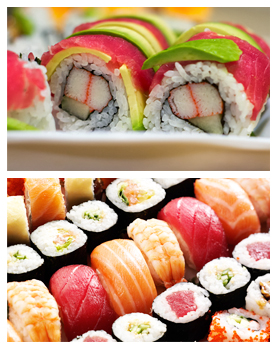5 Health Benefits of Japanese Foods
 Food is an essential and inevitable part of our lives, not only to live; but also to satiate the appetizing food cravings. Nutritious food is the vital source of a long healthy life; however, most of us binge on scrumptious, but unhealthy foods. Japanese food is based upon the principle of health and longevity. Japanese foods are not solely eaten for taste; in fact, they focus on extracting the health benefits from their foods. They think over what could be beneficial for them to eat rather than what they feel to eat. Japanese people are known to live the longest lives and this leads one to contemplate what the secrets of Japanese food are. In this article you will learn to implement the benefits of certain Japanese foods in your kitchen to stay healthy and live longer.
Food is an essential and inevitable part of our lives, not only to live; but also to satiate the appetizing food cravings. Nutritious food is the vital source of a long healthy life; however, most of us binge on scrumptious, but unhealthy foods. Japanese food is based upon the principle of health and longevity. Japanese foods are not solely eaten for taste; in fact, they focus on extracting the health benefits from their foods. They think over what could be beneficial for them to eat rather than what they feel to eat. Japanese people are known to live the longest lives and this leads one to contemplate what the secrets of Japanese food are. In this article you will learn to implement the benefits of certain Japanese foods in your kitchen to stay healthy and live longer.
Heath Benefit 1
The Japanese believe in consuming proteins in greater quantities because of the health benefits associated. They eat a lot of fish instead of red meat because it lowers the dangers of heart attacks. Fish is their staple food because it is a common source to intake proteins. Red meat is comparatively expensive and considered unhealthy. Japanese believe, the healthier the fish; the better it is. Japanese serve fish in raw, poached, grilled, fried and baked forms. Japanese people also believe that fish is the major source to maintain the natural beauty of their skin.
Health Benefit 2
Soy is another popular food item in the Japanese menu. It is known to reduce the risk heart disease and blood pressure. Soy is also a great source of proteins. Just as the fish, soy and Tofu are also staple food products in their diet. Japanese believe that food sourced from soy plant is a great alternate to red meat which is high in saturated fats. Natto, Tofu, Soy sauce etc. are a regular part of the Japanese food as they provide sufficient proteins without cholesterol and saturated fats. These foods reduce the danger of developing numerous chronic diseases.
Heath Benefit 3
The addition of Buckwheat flour immensely helps in the digestion process. It includes minimum amount of starch and contains no traces of white flour. Japanese also consume noodles made from buckwheat flour or wheat flour because they are low in fat and much higher in carbs. This also makes one feel fuller with small portions. It impedes the fat development process in the body and digests quicker than the white flour. It also helps to improve the growth of new blood cells.
Health Benefit 4
Japanese food is always served in smaller portions to discourage overeating. Traditional Japanese food servings are almost half of the servings in the West. The Japanese, however, make it a point that even the healthiest foods are also served in small portions.
Health Benefit 5
Japanese always include green tea with their meals because it fights off the unhealthy elements in the body. It gives similar benefits whether served hot or cold. They prefer green tea over coffee because it contains half the amount of caffeine comparatively. Green tea breaks the oil present in the digestive system. It is mostly served with fried and breaded foods.

